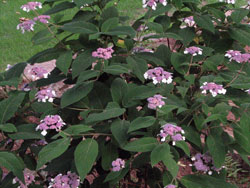Resource Library
Plant of the Week: Sargent’s Hydrangea
The University of Arkansas System Division of Agriculture does not promote, support or recommend plants featured in "Plant of the Week." Please consult your local Extension office for plants suitable for your region.
Plant of the Week
Sargent’s Hydrangea
Latin: Hydrangea sargentiana

My wife wants me to plant more hydrangeas as they are one of her favorite flowers and they remind her of her grandmother. I try to encourage her interest in the garden, but explain that my luck with the macrophylla hydrangeas here in north Arkansas has been pretty dismal. Sure, I can keep the plants alive but they almost never flower. Instead I’m trying to get her to warm up to another species, H. sargentiana, which has done well for me.
Sargent’s hydrangea is a 6- to 8-foot tall and wide deciduous shrub that has coarse branches and a somewhat open form. The leaves of this species are extremely fuzzy and covered on both surfaces with a long pubescence. The ovate leaves on the lower part of the plant may be as much as 10 inches long with a 3-inch long fuzzy petiole while leaves on flowering stems are about half as large. There is no fall color with leaves dropping with the first frost.
The flat 8-inch diameter lace-cap type flower heads are produced in early to mid summer. The innermost and small fertile flowers are purple-violet in color and ringed by a fringe of white sterile florets that may be as much as 1.5 inches across.
Sargent’s hydrangea was introduced from the mountains of south-central China’s Hubei Province in 1908 by my favorite plant explorer, E. H. “China” Wilson. Wilson made four major multi-year expeditions into China from 1898 to 1910 where he collected and introduced more than 2,000 new plants. His first trip was in the employ of a venerable English nursery, but thereafter he was sent out by Harvard’s Arnold Arboretum.
This shrubby hydrangea is named in honor of Charles Sprague Sargent (1841 – 1927), Wilson’s boss at the Arnold Arboretum where he served as director for 55 years. Sargent was scion of a rich and influential Boston family with the money and connections necessary to build the planting into the world-class institution it has become. During his tenure Sargent, became one of the foremost tree experts in the nation. Upon Sargent’s death Wilson became keeper of the Arboretum until he and his wife were killed in 1930 in a car crash.
Sargent’s hydrangea is not commonly seen in southern gardens but is said to be more common in the Pacific Northwest and Europe. Authorities claim it to be more tender than the typical H. macrophylla clone which is usually listed as a zone 5 plant. But in my zone 6/7 garden H. sargentiana flowers every year but the more common house hydrangea only produces an occasional flower for me.
My theory on this difference in blooming performance between the two species is winter flower bud hardiness. It seems to me that winter kill – either in the form of too low a temperature during the winter or a late season spring frost – often kills the blooms of the common hydrangea in my garden. H. sargentiana may only be winter hardy to zone 6 but both its stems and flowers are hardy to the same degree. In the common house hydrangea the flower buds are decidedly less winter hardy than the stems.
Like most hydrangeas Sargent’s hydrangea should be planted in a moist, reasonably fertile site in partial, but not heavy, shade. It can be used in the foundation planting or the border, but its larger size than the house hydrangea makes it better suited for back-of-the-border planting. If pruning is needed to control size, prune immediately after blooming.
By: Gerald Klingaman, retired
Extension Horticulturist - Ornamentals
Extension News - July 31, 2009
The University of Arkansas System Division of Agriculture does not maintain lists of retail outlets where these plants can be purchased. Please check your local nursery or other retail outlets to ask about the availability of these plants for your growing area.